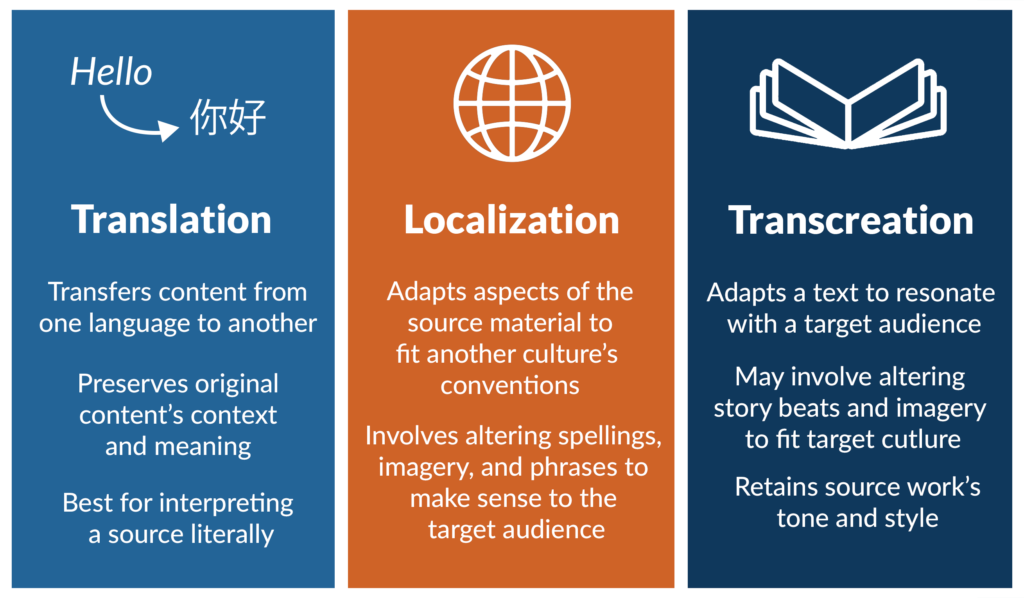In today’s globalized world, businesses are increasingly looking to expand their reach beyond their home markets. One of the most effective ways to do this is through language services like marketing translation and localization. While these terms are often used interchangeably, they are not the same. This article aims to clarify the meaning of translation and localization and help you decide which service is best for your specific needs. Understanding the nuances between these two services is crucial for any business aiming for international success. Knowing when to use translation and when to opt for localization can make all the difference in how well your product or service is received in foreign markets.
What is Localization in Translation Studies?
In the academic field of translation studies, localization is considered an extension of translation. It goes beyond the mere conversion of text. It includes adapting various elements like images, layout, and even the functionality of a product or service to suit the preferences of a specific target market. This makes localization a multidisciplinary effort that involves not just translators but also marketers, designers, and engineers. The complexity of localization makes it a subject of interest in academic circles, where scholars examine how cultural, social, and even political factors can influence the localization process.
What are Examples of Localization in Business?
Examples of localization in business are abundant. For instance, McDonald’s offers a “McAloo Tikki” burger in India, which caters to local vegetarian dietary preferences. Similarly, Netflix provides subtitles and dubs its shows in multiple languages, even altering the content to avoid cultural taboos or sensitivities using localization and transcreation. These strategic moves make the product or service more relatable to a local audience. Such examples underscore the importance of localization in today’s global business environment, where understanding and adapting to local tastes and preferences can be a significant competitive advantage.
What are the Types of Localization in Translation?
There are several types of localization in translation, including website, software, and mobile app localization. Each type involves a unique set of challenges and requires specialized skills. For example, website localization may involve adapting the site’s layout to accommodate languages that read from right to left, like Arabic. Software localization could require altering the user interface to suit local preferences. Understanding these types is essential for businesses to choose the right localization strategy, ensuring that they effectively address the specific needs and challenges of each target market.
What is the Difference Between Localization and Translation?

The difference between localization and translation is primarily in the scope and depth of the work involved. Translation is the process of converting text from one language to another, focusing on linguistic accuracy. On the other hand, localization involves a more comprehensive adaptation of content or product to fit a target market’s cultural, legal, and linguistic preferences. This distinction is crucial for businesses to understand, as it helps them allocate resources more effectively and choose the right service for their specific needs, whether it involves a simple translation or a more complex localization project.
How is Localization Different from Direct Translation?
Localization differs from direct translation by considering cultural nuances and local customs. For example, a direct translation of an English website into Japanese might be linguistically accurate but could miss out on cultural references, making the content less engaging for a Japanese audience. Localization addresses these gaps by adapting the content to local sensibilities. This involves a deep understanding of the target culture, including its history, traditions, and humor, to ensure that the localized content resonates with the audience.
Does Localization Include Translation?
You might wonder: does localization include translation? The answer is yes; localization includes translation but extends beyond it. While translation focuses solely on converting text, localization involves a broader range of adaptations, including changes to graphics, formatting, and even code, to ensure that the product or service is fully functional and culturally appropriate for the target audience. This comprehensive approach makes localization more involved and often more costly than translation. Still, the investment is usually well worth it for businesses looking to truly connect with a new market.
How to Find Localization Services
If you’re looking to localize your business, choosing the right service provider is essential. Some of the top localization companies in the world include Lionbridge, TransPerfect, and SDL. These companies offer services from basic translation to full-scale localization projects, ensuring your business can effectively reach new markets. Choosing a reputable company is crucial for the success of your localization efforts, as the quality of the work will directly impact how well your product or service is received in the target market.
Understanding the difference between translation and localization is crucial for businesses expanding globally. While translation is an essential first step, localization ensures that your product or service is understandable, relatable, and engaging to your target audience. By investing in both, companies can ensure a more effective and impactful entry into new markets. In conclusion, whether you’re a small business looking to venture into a new market or a multinational corporation aiming for global dominance, understanding the key differences between translation and localization can guide you in making informed decisions that will ultimately contribute to your success.
Have a Project in Mind?
If you’ve got a localization project in the works, don’t wait! Traduality has everything you need to succeed; create your first project today and find vetted translators, or book a meeting with us to learn more about your specific needs.
Updated 2/21/2024.





0 Comments